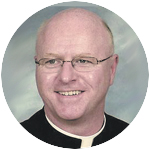
Msgr. Joseph Prior
(See the readings for the Fifth Sunday of Lent, March 21)
The cross is probably the most used image in Christian art and symbolism. Many of us carry a crucifix on our person. Every Catholic church has the crucifix in a prominent position in the sanctuary. The naves of our churches have the stations of the cross. Our homes have a crucifix or cross above our doors.
The image of the cross conjures up our collective memory of Jesus’ passion which is central to understanding the Christian life.
The Gospel passage for this Sunday’s liturgy (Cycle B) recalls one of Jesus’ instructions to the disciples as he nears his passion. The reading is packed with sayings that point us to and give us insight into the passion that the Lord is undergoing and the death we will mark next Sunday.
“The hour has come for the Son of Man to be glorified.” The terms “hour” and “Son of Man” point to judgment. The time of judgment has come. The “Son of Man” is the title of the “judge” — the final judgment.
[hotblock]
The term “glorified” is related to “being revealed” or “made manifest.” Jesus will show God’s judgment on the world through his death which is signified by his “hour.” The judgment of the world is coming.
The term “world” is used often in the Gospel. Jesus uses this word in a specific way. This is not the typical way we use the word today. For most of us the word would imply the “earth” or the “universe.” Jesus uses the term to express that which is not of God or not united with God or distant from God. In this sense we might use the term “the way of the world.”
Jesus’ faithfulness to the Father and his union with him will be perfectly or completely made manifest in his passion and death. He will “take on” the forces of the world, and the leader of this world and return man to his proper place with God. This will entail a re-orientation.
Jesus uses the image of the grain of wheat that must fall to the ground and die as a description of his passion and death. He forsakes the world and its leader. He will die but bear much fruit, eternal life for all who follow him. Hence the image applies to all who seek to follow him. His disciples (us) must die to the world and live for God. “Whoever loves his life loses it, and whoever hates his life in this world will preserve it for eternal life.”
Life does not come from the world. It comes from the Father. Hence our orientation in this life is not focused on the world or worldly things, ideas or desires. Forsaking these brings one to true life, eternal life. The orientation toward God comes through following the Son. Jesus will bring those who follow him with him to the Father and they shall be honored. The servant-master relationship of the world is now turned up-side down.
[hotblock2]
The magnitude of what Jesus is about to undergo is something of which he is keenly aware. “I am troubled now.” His impending passion and death are overwhelming but it must be embraced so he can accomplish his mission. His faithfulness to the Father has been true all through his life.
Jesus’ focus is on the Father as he makes his prayer: “Father, glorify your name.” Jesus comes from the Father to lead mankind to the Father. He comes to reveal the Father and his love and mercy. He comes not only to lift up fallen man but to invite him into divine life, eternal life. At this point, the Father responds so all can hear: “I have glorified it and will glorify it again.”
As the people murmur and wonder at the voice, Jesus returns to the theme of judgment. “Now is the time of judgment on this world.” His judgment is manifest in faithfulness to the Father. He is obedient to the end. In this obedience, Jesus manifests complete faith and trust in the Father. He chooses the Father over the world and in doing so will drive out the ruler of the world — not out of existence, but out of power.
The “ruler of this world” hearkens back to the serpent in Genesis, who time and time again slivers into the life of man. His goal is to orient man toward himself and the things of the “world.” In doing so, he seeks power over man. He seeks to rob man of life.
This power is broken by Jesus who, standing in for all mankind, refuses to yield to the world or the ruler of the world but remains faithful – all the way to his death. His faithfulness marks the judgment of the world, a judgment in love and mercy. This will all be accomplished on the cross: “And when I am lifted up from the earth, I will draw everyone to myself.”
***
Msgr. Joseph Prior is pastor of Our Lady of Grace Parish, Penndel, and a former professor of Sacred Scripture and rector of St. Charles Borromeo Seminary.



Share this story